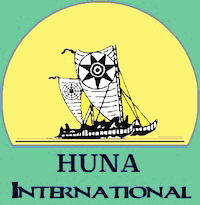Huna Article
Huna International
Visit To The Ryukyu Islands
by Mariko Kamimura
One of my goals has been to find the connection between Japan and Hawaii in the ancient times since there
seem to be so many similar ideas in rituals, about gods and about spirituality in general. From Dec 20th,
2005 to Jan. 2006, I finally made myself go to Okinawa and the Ryukyu Islands for 3 weeks to see the traces.
Most interesting were the underwater ruins off Yonaguni Island at the very end of the chains of Ryukyu
Islands, closest to Taiwan. To give you a brief geology of this Ryukyu Islands, there are more than 60
islands, including the largest, Okinawa Island. These islands are said to be about 5 to 1.7millions years
old when they actually became separated from the Asian continent when the sea levels rose. As the earth went
through several upheavals the Ryukyu Islands went under water here and there, and what we see
today has remained the same for about 5000 to 13000 years.
Just to compare, the Earth is about 4.6 billion years old and Kauai is around 5.1 million years old.
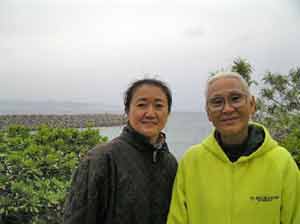 The first thing to be known is that shamanism has been there and is still alive in the Ryukyu islands. The
lady in the accompanying photo is a shaman from the island of Kudaka that is a 20 minute boat ride from the
east end of Okinawa Island. Maeda-san is the only official Noro (shaman) left here. And because this island
is the most sacred, it would make her the highest ranking Noro of all.
The first thing to be known is that shamanism has been there and is still alive in the Ryukyu islands. The
lady in the accompanying photo is a shaman from the island of Kudaka that is a 20 minute boat ride from the
east end of Okinawa Island. Maeda-san is the only official Noro (shaman) left here. And because this island
is the most sacred, it would make her the highest ranking Noro of all.
Kudaka is said to be the most sacred of all islands. This photo was taken on a rainy morning the day I was
going to visit the island. The light shone only right on Kudaka, as if telling me, "Welcome! Here it is! The
divine place". It is a very small island of 300 population. Here on this island, it is a utopia.
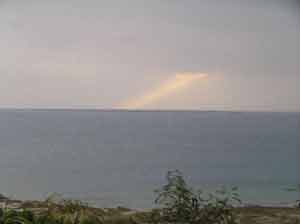 Everyone above the age of
17 is given an equal amount
of land, which they can use until they turn 70. At 70 the whole village gives a celebration and the person
retires, and the land will be given to the next generation. There are no stores. People make their own food
in the fields, catch fish in the ocean for that day, and share. They still strictly follow the rituals
according to Noro tradition (Interestingly enough, in Ryukyu, the chief shaman is always female). As most of
the other Ryukyu islands are simplifying or not doing the rituals at all, this is the only place where they
still do everything as in the old days. When you ask the local people in other islands about Kudaka, they
say it is not a place to go to, because the Gods live there. Only when you have to go for a spiritual reason
are you invited. They are even sort of scared about the place. Spiritual matters seem like a scary thing for
them, and a lot of the younger generation want to leave the tradition, because the old ways seem to strict,
and the younger people want more freedom. Everyone above the age of
17 is given an equal amount
of land, which they can use until they turn 70. At 70 the whole village gives a celebration and the person
retires, and the land will be given to the next generation. There are no stores. People make their own food
in the fields, catch fish in the ocean for that day, and share. They still strictly follow the rituals
according to Noro tradition (Interestingly enough, in Ryukyu, the chief shaman is always female). As most of
the other Ryukyu islands are simplifying or not doing the rituals at all, this is the only place where they
still do everything as in the old days. When you ask the local people in other islands about Kudaka, they
say it is not a place to go to, because the Gods live there. Only when you have to go for a spiritual reason
are you invited. They are even sort of scared about the place. Spiritual matters seem like a scary thing for
them, and a lot of the younger generation want to leave the tradition, because the old ways seem to strict,
and the younger people want more freedom.
As in Hawaii, in the Ryukyus and in Japan we have many gods and goddesses for almost everything. In Hawaii
they say kini (forty thousand), in Japan we say Yorozu (eight thousand). It just means there
are many for each and everything.
In Kudaka they use a vine called Habui as a crown for formal rituals, like in Hawaii they use a maile
vine, or a haku crown with ti leaves. They use the moon calendar like many shamans around the
world. The sacred places are built with low rock walls like the Hawaiian heiau.
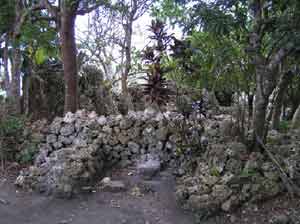 They chant and dance on
certain occasions. Commom people were not allowed to be there. Only the shamans were allowed to go in for
certain events. I had the privilege to tour around the island with Maeda-san, the Noro. She would be talking
to the birds as we went along. She told me to pray when we got to the sacred places. "Just simply send a
thank you," she said. She gave me a very interesting insight about myself when we got to the female sacred
place. That I will not get into, but she was quite aware of what was happening in my life, that I can say. They chant and dance on
certain occasions. Commom people were not allowed to be there. Only the shamans were allowed to go in for
certain events. I had the privilege to tour around the island with Maeda-san, the Noro. She would be talking
to the birds as we went along. She told me to pray when we got to the sacred places. "Just simply send a
thank you," she said. She gave me a very interesting insight about myself when we got to the female sacred
place. That I will not get into, but she was quite aware of what was happening in my life, that I can say.
After travelling around five islands, I finally got to Yonaguni. Thank God the tides were so strong that the
ship was cancelled and I got to take the airplane instead. I was so sick of the boat rides after touring
around five islands and I was told that to go to Yonaguni is the worst, with its 5 hours of strong current!
I'm so glad that I had an excuse to take the airplane ride even though the price was much higher.
 The highlight of Yonaguni Island, where Graham Hancock, author of Fingerprints of Gods is researching
for his latest subject, consists of the underwater ruins and some of the stone carvings on the island above
ocean. The underwater structure is 250 meters (800 feet) east-west by 150 meters (500 feet) north-south, and
25 meters (80feet) in height. It is under 20-40 meters of water on the southeast side of the island. In the
same area are some carvings on a cliff: an eagle 10 meters long and an interestingly-shaped giant rock
(rock.jpg) that could be natural, but looks like a moai statue, like those on Easter Island. I have
actually been very close to this rock and it had the most amazing magnetic field or something. I could not
leave that place for a very long time. It was moving my energy so strongly that I actually had tears coming
out of my eyes. My heart chakra was opened and released a lot of energy there.
The highlight of Yonaguni Island, where Graham Hancock, author of Fingerprints of Gods is researching
for his latest subject, consists of the underwater ruins and some of the stone carvings on the island above
ocean. The underwater structure is 250 meters (800 feet) east-west by 150 meters (500 feet) north-south, and
25 meters (80feet) in height. It is under 20-40 meters of water on the southeast side of the island. In the
same area are some carvings on a cliff: an eagle 10 meters long and an interestingly-shaped giant rock
(rock.jpg) that could be natural, but looks like a moai statue, like those on Easter Island. I have
actually been very close to this rock and it had the most amazing magnetic field or something. I could not
leave that place for a very long time. It was moving my energy so strongly that I actually had tears coming
out of my eyes. My heart chakra was opened and released a lot of energy there.
The underwater buidling, unfortunately, I could not see with my own eyes since you need to be a very skilled
scuba diver to get there. The currents are very strong.
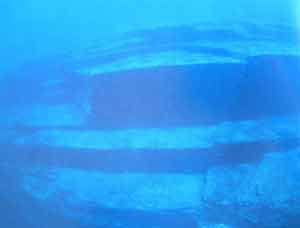 But this photo is from a book, Diving Survey Report for Submarine Ruins Off Yonaguni,
Japan by Prof. Masaaki Kimura, University of the Ryukyus. This shows the "main terrrace," as they call
it, the most beautiful part of the whole ruins. From their research it is estimated that these ruins could
be 9,000 to 10,000 years old or even older. One of the glacial periods is said to have ended around 13,000
years ago, and the sea level rose almost 100 meters. This might mean that maybe these ruins sank at that
time, which means it could be over 13,000 years old. If this is proven, it will be the oldest and largest
ancient ruins ever found. I have also read somewhere that the time of Mu was around this time. It is truly
exciting to think that maybe this was a major temple or a center for rituals. There are many parts of these
ruins that indicate that it was a temple-like place. It has lots of complex stairways and passages, flat
areas, a stadium-like structure, a round clock-like stone, a turtle-shaped rock, a giant face with eyeballs
carved inside... etc, etc..There is also a wall around this structure that is like what you see at a heiau a
wall that is made by buiding up small rocks. This one has large rocks and small rocks combined, which you
can see at heiaus in the Society Islands.
But this photo is from a book, Diving Survey Report for Submarine Ruins Off Yonaguni,
Japan by Prof. Masaaki Kimura, University of the Ryukyus. This shows the "main terrrace," as they call
it, the most beautiful part of the whole ruins. From their research it is estimated that these ruins could
be 9,000 to 10,000 years old or even older. One of the glacial periods is said to have ended around 13,000
years ago, and the sea level rose almost 100 meters. This might mean that maybe these ruins sank at that
time, which means it could be over 13,000 years old. If this is proven, it will be the oldest and largest
ancient ruins ever found. I have also read somewhere that the time of Mu was around this time. It is truly
exciting to think that maybe this was a major temple or a center for rituals. There are many parts of these
ruins that indicate that it was a temple-like place. It has lots of complex stairways and passages, flat
areas, a stadium-like structure, a round clock-like stone, a turtle-shaped rock, a giant face with eyeballs
carved inside... etc, etc..There is also a wall around this structure that is like what you see at a heiau a
wall that is made by buiding up small rocks. This one has large rocks and small rocks combined, which you
can see at heiaus in the Society Islands.
A Kahuna on Kauai told me that the Okinawan people are Mu people. I asked the Noro if they talk about Mu.
She looked far towards the ocean for one breath and gave me a short answer "Yes, we do."
The mystery and my wild imagination has fully excited me. I do not know when my next trip will be to the
Ryukyu Islands but it might already be in the time of Mu, right there, very close....
Copyright Huna International 2006
|
